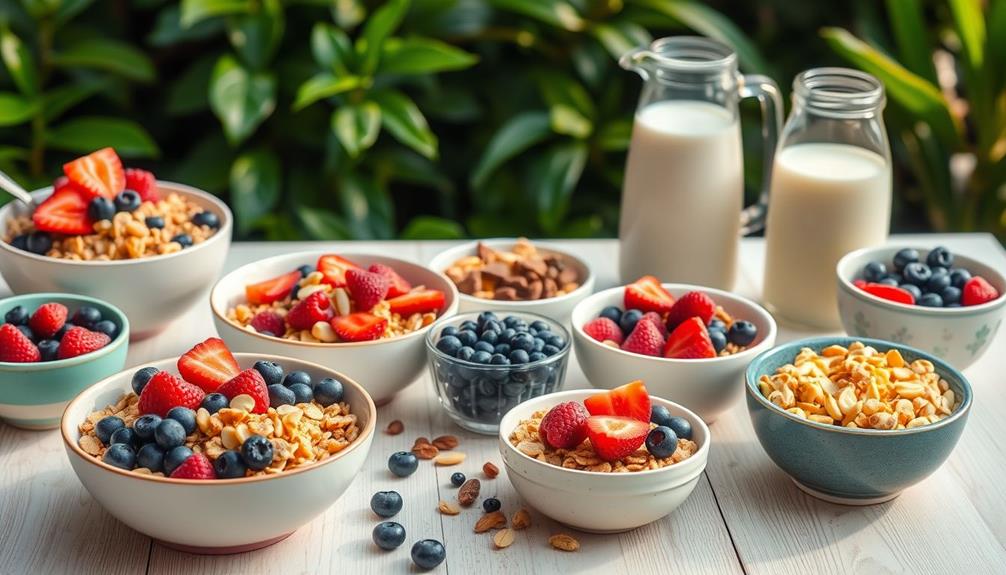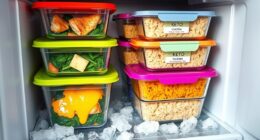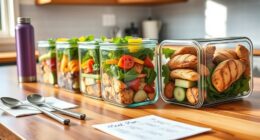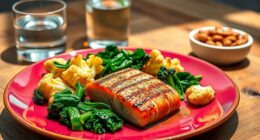Yes, there are plenty of tasty keto breakfast cereals designed for your low-carb lifestyle. Brands like Magic Spoon and Catalina Crunch offer options with net carbs around 4-5 grams per serving and high protein content, making them filling and satisfying. Wonderworks is another great choice, boasting only 3 grams of net carbs per serving. You can also explore homemade options like grain-free granola or low-carb muesli, giving you control over ingredients. Just be cautious of misleading products that might exceed your carb limits. Keep exploring to discover the perfect keto breakfasts that suit your taste!
Key Takeaways
- Yes, keto breakfast cereals exist, designed to keep net carbs below 5 grams per serving while being high in protein and fiber.
- Popular brands include Magic Spoon, Catalina Crunch, and Wonderworks, each offering various flavors and nutritional profiles.
- Homemade options like grain-free granola and low-carb muesli allow for customizable ingredients and flavors to suit dietary needs.
- Ideal pairings for keto cereal include unsweetened almond milk, low-carb berries, and sugar-free yogurt to enhance taste and nutritional value.
- Always check nutritional labels to avoid misleading products that exceed keto-friendly carb limits and contain hidden sugars.
What Is Keto Cereal?
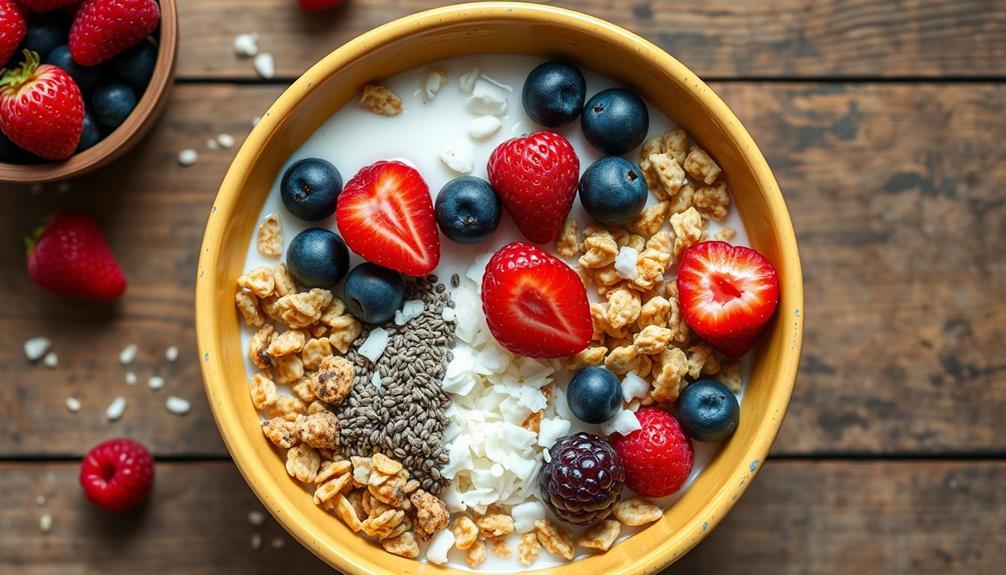
Keto cereal is a game changer for anyone following a low-carb diet. Unlike traditional cereals, which are often loaded with carbs, keto-friendly cereal options are specifically designed to keep your net carbs per serving below 5 grams. This makes it easier for you to maintain ketosis while still enjoying a delicious breakfast.
These cereals are typically high in protein, often exceeding 10 grams per serving, helping you feel full and satisfied throughout the morning. Many keto cereals also incorporate dietary fiber, promoting digestive health and offering additional nutritional benefits.
To cater to health-conscious consumers, brands are using grain-free ingredients and low-carb sweeteners that recreate the familiar flavors of your childhood favorites.
In 2023, the keto cereal market has expanded considerably, with popular brands like Magic Spoon and Catalina Crunch leading the way in flavor variety and nutritional quality.
Types of Keto Cereals
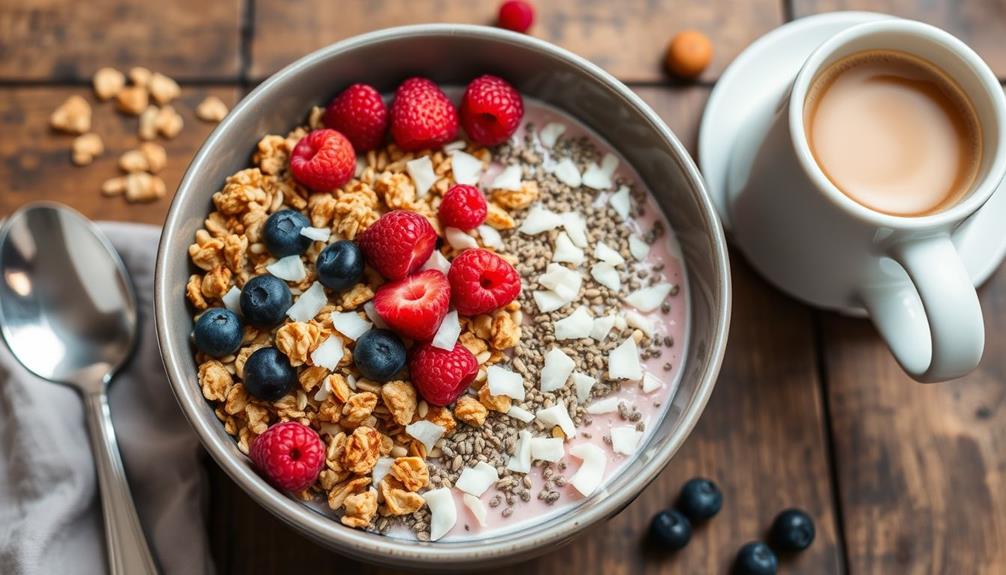
A variety of keto cereal options is available to suit different tastes and dietary preferences. You can find low-carb and high-protein keto cereals that often contain less than 5 grams of net carbs per serving, making them perfect for your low-carb lifestyle.
Brands like Magic Spoon and Catalina Crunch stand out with their unique flavors and impressive nutritional profiles, typically offering over 10 grams of protein per serving.
If you prefer a more personalized approach, consider making homemade keto cereals that resemble granola. This way, you can control the ingredients and customize the flavors to meet your dietary needs.
Some store-bought keto cereals are fortified with vitamins and minerals, providing additional nutritional benefits beyond just being low-carb.
However, it's essential to check the nutritional labels carefully. Not all cereals labeled as keto truly meet the low-carb criteria, and some may have misleading carbohydrate counts.
Best Keto Cereal Brands
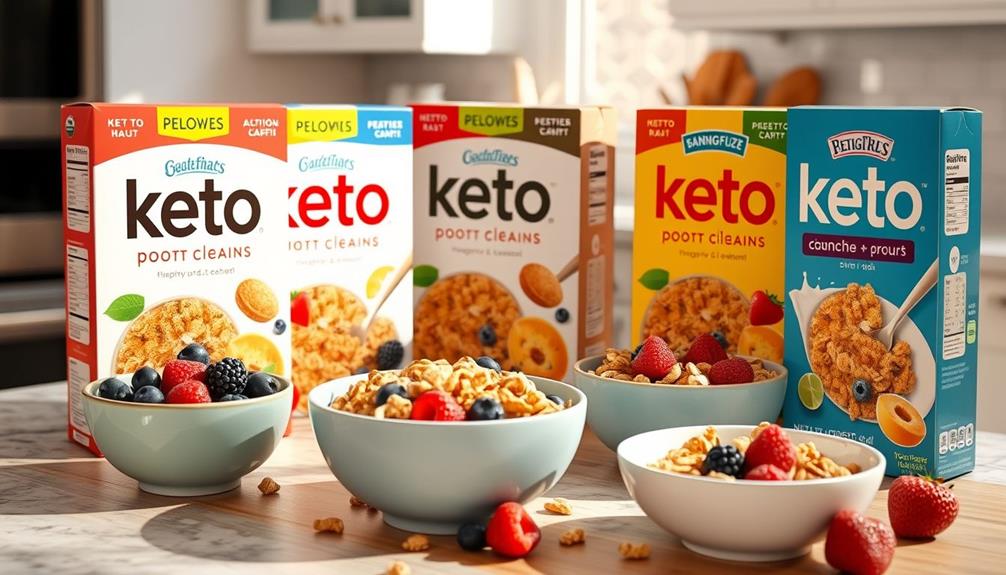
When it comes to choosing the best keto cereal brands, you'll find a variety of options that cater to different tastes and nutritional needs.
We'll compare top brands like Magic Spoon and Catalina Crunch, highlighting their nutritional profiles and flavor varieties.
Let's explore which cereals can fit perfectly into your keto lifestyle while satisfying your cravings.
Top Brand Comparisons
Finding the right keto cereal can make all the difference in your breakfast routine. When looking for the best keto cereal options, consider brands like Magic Spoon and Catalina.
Magic Spoon stands out with 4-5 net carbs and 13-14g of protein per serving, offering a delicious variety of flavors for $39 for 20 servings. Catalina Crunch is another great choice, featuring plant-based ingredients with 5 net carbs and 11g of protein per serving, priced at $49 for 28 servings.
If you want the lowest net carbs, Wonderworks is your best bet, boasting just 3g per serving along with 17g of protein, making it a competitive option at $23 for 21 servings.
HighKey Snacks also focuses on low sugar, gluten-free options, perfect for health-conscious consumers.
Finally, Keto and Co offers unique flavors like Chocolate Sea Salt, with net carbs ranging from 2.1g to 3.5g per serving, making it ideal for anyone on a ketogenic diet.
Nutritional Profiles Overview
Exploring the nutritional profiles of top keto cereal brands can help you make informed choices for your breakfast. Each option varies in net carbs, protein, and overall suitability for a keto diet.
Magic Spoon stands out with a serving size of 1 cup, offering just 4-5 net carbs and 13-14 grams of protein. It uses natural sweeteners like allulose and stevia, keeping the glycemic impact low.
If you prefer a plant-based, gluten-free choice, Catalina Crunch provides 5 net carbs and 11 grams of protein in a 1/2 cup serving.
For those focused on high protein, Wonderworks delivers with 7 net carbs and a robust 17 grams of protein per 1 cup serving.
If you're in the mood for something warm, Keto and Co has hot cereals and granola with net carbs ranging from 2.1g to 3.5g and 3-4 grams of protein.
Finally, HighKey Snacks emphasizes low sugar and gluten-free options, ensuring you can enjoy a keto-friendly cereal without compromising on health.
Each of these brands provides a solid breakfast choice tailored for your keto diet!
Flavor Variety Highlights
Keto cereal brands have risen to the occasion, offering a delightful array of flavors that cater to various palates. Magic Spoon tempts with six unique options like Fruity and Cinnamon Roll, all while keeping net carbs between 4-5 grams and protein content high at 13-14 grams. You can easily enjoy a bowl of keto cereal with your favorite milk for a satisfying breakfast.
Catalina Crunch adds to the mix with flavors like Chocolate and Cinnamon Toast, providing 5 grams of net carbs and 11 grams of protein per serving.
If you're looking for higher protein content, Wonderworks offers Peanut Butter and Chocolate with just 3 grams of net carbs and an impressive 17 grams of protein.
For those who crave something different, Keto and Co features Chocolate Sea Salt and Peanut Butter Crunch, boasting net carbs between 2.1g-3.5g.
If you're feeling adventurous, Three Wishes offers Cocoa and Cinnamon, but keep in mind it has 20 grams of carbs.
With these cereal flavors, you can enjoy quick and easy keto breakfasts without sacrificing taste!
Misleading Products to Avoid
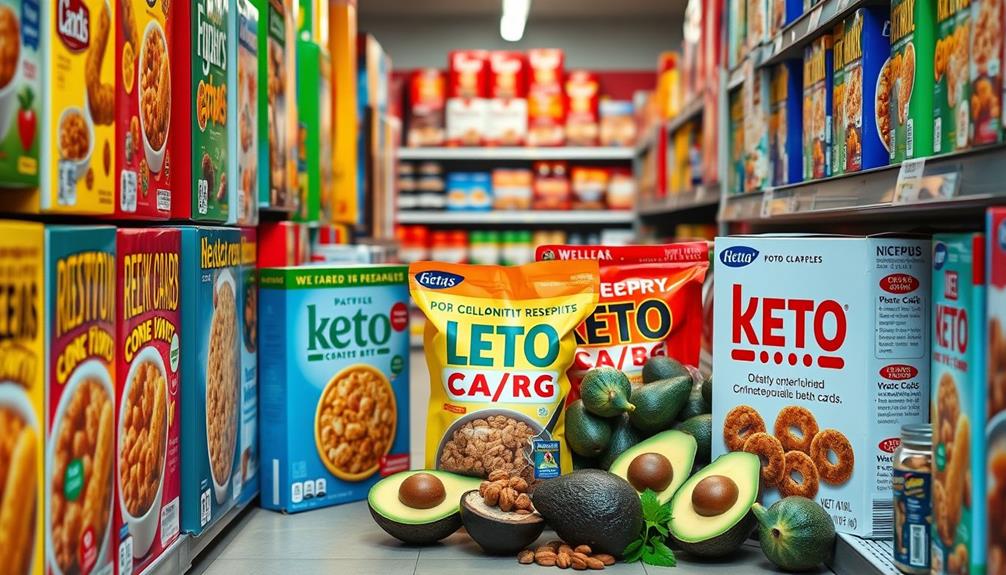
When you're choosing a keto cereal, it's essential to watch out for misleading products that claim to be keto-friendly.
Many popular brands, like Cheerios and Special K, pack in way more carbs than you want, which can throw off your diet.
Always check the nutritional labels to spot high-carb ingredients and guarantee you're really sticking to your keto goals.
Common High-Carb Cereals
Many popular breakfast cereals can sabotage your keto goals, often hiding high carbohydrate counts behind misleading labels. Common high-carb cereals like Cheerios and Special K can contain over 20g and even 50g of carbs per serving, making them unsuitable for a ketogenic diet.
Even seemingly healthier options, like Three Wishes cereal, still pack around 20g of carbs, far exceeding the keto-friendly threshold of under 5g net carbs.
When you're scanning the cereal aisle, make sure to check the nutritional information carefully. Regular cereals, including favorites like Cinnamon Toast Crunch, are typically loaded with sugar and carbs that can derail your diet.
Even products marketed as high-protein often contain sugar alcohols that contribute to net carbs, complicating your choices.
It's essential to remember that not all cereals labeled as healthy are actually keto-compliant. Always verify the net carb count before purchasing to avoid unwanted carbs sneaking into your breakfast.
Labeling and Ingredient Misleading
Maneuvering the cereal aisle can feel like a minefield, especially with products masquerading as keto-friendly. Many cereals marketed as so are misleading, often packed with higher net carbs that can sabotage your ketogenic journey.
For instance, you might find cereals like Cheerios and Special K containing upwards of 50g of carbs per serving, which is far from an ideal keto cereal choice.
To navigate this tricky landscape, keep an eye out for these red flags:
- Vague marketing terms: Beware of claims that lack clear nutritional details.
- Hidden sugars: Check ingredient lists for sneaky high-carb components.
- High net carbs: Avoid cereals exceeding 5g of net carbs per serving.
Even seemingly healthy options like Three Wishes can mislead, offering high protein yet still packing around 20g of carbs.
To stay on track, always review product reviews and ingredient lists thoroughly. Consider making your own homemade keto cereal to guarantee you know exactly what goes into it.
Nutritional Benefits of Keto Cereal
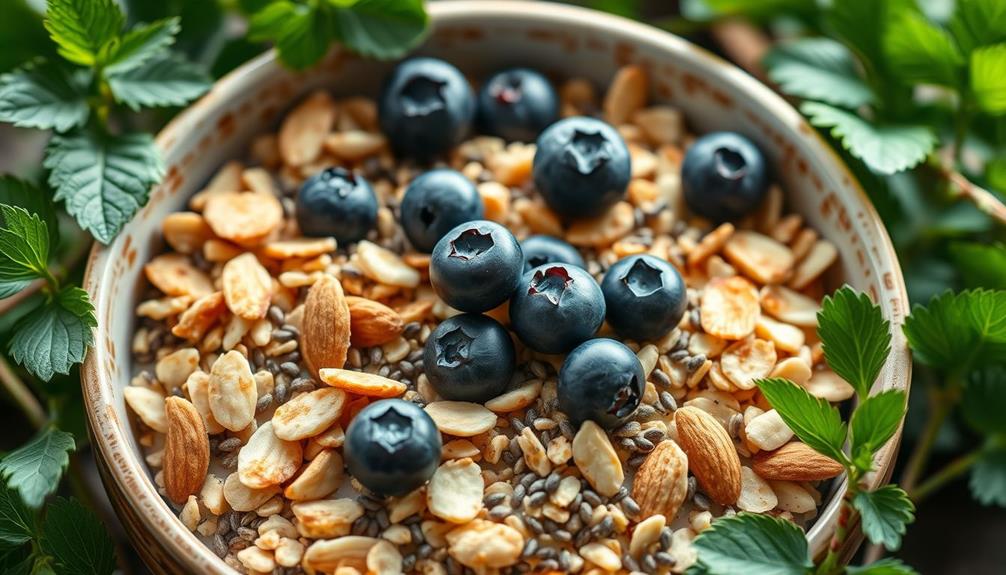
Keto cereals offer a smart choice for those looking to maintain a low-carb diet without sacrificing taste or nutrition. When you pour a bowl of keto cereal, you'll typically enjoy less than 5 grams of net carbs per serving, which helps you stay in ketosis. This makes it an ideal breakfast option compared to traditional cereals that often exceed 20 grams of carbs.
In addition to being low-carb, most keto cereals are high in protein, often exceeding 10 grams per serving. This boost in protein not only promotes satiety but also supports muscle maintenance, making it easier to stick to your dietary goals.
Plus, the rich dietary fiber found in these cereals aids in digestion and helps to control blood sugar levels, thanks to their low glycemic index.
Many keto cereals are also fortified with essential vitamins and minerals, which adds to their health benefits. By choosing a keto cereal, you're not just opting for a low-carb meal; you're also fueling your body with nutrients while enjoying a delicious breakfast that keeps you satisfied.
Homemade Keto Cereal Ideas
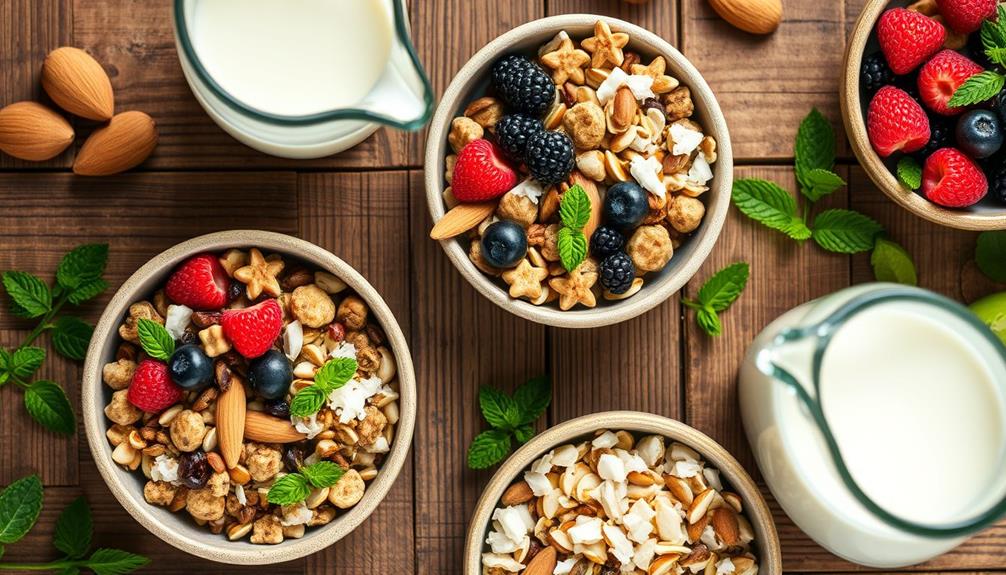
If you're looking to whip up a delicious breakfast that aligns with your low-carb lifestyle, homemade keto cereal is a fantastic option. You get to customize your ingredients, allowing for better control over your macro ratios and often saving money compared to store-bought cereals.
Here are a few easy homemade cereal recipes you can try:
- Grain-Free Granola: Combine nuts and seeds to create a crunchy granola that averages just 3 grams of net carbs per serving.
- Low-Carb Muesli: Mix sliced almonds, flaked coconut, and chia seeds for a nutritious and filling breakfast alternative.
- Spiced Options: Enhance flavors by adding cinnamon or vanilla extract without increasing carbs, making it perfect for your keto breakfast.
Meal prepping your homemade keto cereal in bulk can save time during those hectic mornings while keeping you on track with your dietary goals.
With these ideas, you can enjoy a delightful and satisfying breakfast that fits perfectly into your low-carb lifestyle!
Pairing Foods With Keto Cereal
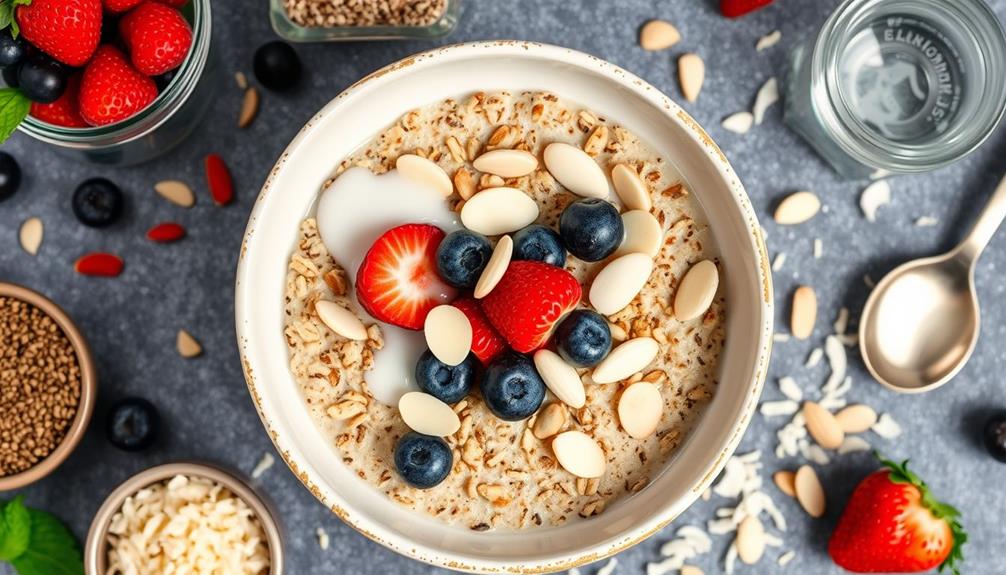
When enjoying your homemade keto cereal, pairing it with complementary foods can elevate your breakfast experience. Start by pouring unsweetened almond milk over your bowl of cereal. It's low in carbs and calories, making it perfect for your keto diet.
Consider adding homemade yogurt, like Instant Pot coconut yogurt, for a creamy texture without the sugar. To boost your meal's protein content, sprinkle in some pea protein, or top your cereal with a handful of nuts or seeds. These not only enhance the crunch but also provide healthy fats and additional protein.
If you're looking to add natural sweetness, toss in a few berries, such as raspberries or blackberries. They're low in carbs and can transform your bowl into a flavorful delight.
For a dessert-like twist, try serving your keto cereal atop sugar-free ice cream. This creates a delicious treat that's perfect any time of day. By strategically pairing these foods, you'll enjoy a satisfying and nutritious breakfast while sticking to your keto goals, keeping your carb count in check at just a few grams per serving.
Frequently Asked Questions
What Is the Best Keto Breakfast Cereal?
When choosing the best keto breakfast cereal, look for options with under 5 grams of net carbs per serving. Brands like Magic Spoon and Wonderworks provide delicious, high-protein choices that fit your dietary needs perfectly.
What Is the Best Keto Cereal in the Store?
When you're shopping for keto cereal, consider options like Magic Spoon or Wonderworks. They offer low net carbs and high protein. Check labels to find the best fit for your dietary needs and flavor preferences.
Are Cheerios Ok for Keto?
"You are what you eat." Cheerios aren't okay for keto; they pack around 20g of carbs per serving. Instead, grab keto-friendly cereals with lower net carbs and higher protein to stay on track with your diet.
What Is the Cereal With the Least Amount of Carbs?
If you're searching for a cereal with the least amount of carbs, consider options like Wonderworks with 3 grams or Magic Spoon and Catalina Crunch, both offering low net carbs and high protein.
Conclusion
In a world where breakfast cereals are often loaded with sugar and carbs, embracing keto cereal feels almost rebellious, doesn't it? You're trading sugary bowls for nutty crunch and satisfying flavors, all while staying true to your low-carb goals. Who knew that a simple shift could turn breakfast into a guilt-free pleasure? So, go ahead and enjoy your keto cereal—after all, it's just a clever way to indulge while sticking to your diet. How delightfully ironic!
